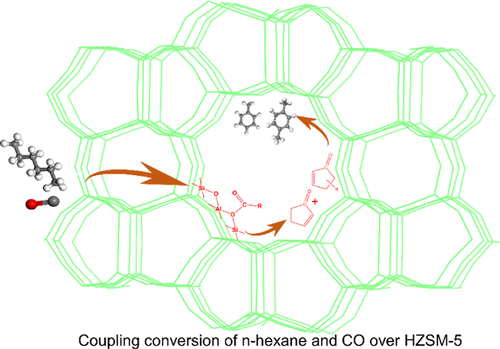当前位置:
X-MOL 学术
›
ACS Catal.
›
论文详情
Our official English website, www.x-mol.net, welcomes your
feedback! (Note: you will need to create a separate account there.)
Coupling Conversion of n-Hexane and CO over an HZSM-5 Zeolite: Tuning the H/C Balance and Achieving High Aromatic Selectivity
ACS Catalysis ( IF 11.3 ) Pub Date : 2020-03-19 , DOI: 10.1021/acscatal.9b05619 Changcheng Wei 1, 2 , Qijun Yu 1, 2 , Jinzhe Li 1 , Zhongmin Liu 1
ACS Catalysis ( IF 11.3 ) Pub Date : 2020-03-19 , DOI: 10.1021/acscatal.9b05619 Changcheng Wei 1, 2 , Qijun Yu 1, 2 , Jinzhe Li 1 , Zhongmin Liu 1
Affiliation

|
The coupling conversion of n-hexane (a model compound of naphtha) and CO was conducted over an HZSM-5 zeolite catalyst. A significant increase in the aromatic selectivity and dramatic decrease in the alkane selectivity were simultaneously achieved by adjusting the H/C ratio of the reactants. Under suitable conditions, the aromatic selectivity was 80%, which far exceeds the theoretical value for the conversion of only n-hexane over HZSM-5. Detailed studies revealed that the high aromatic selectivity originated from the direct incorporation of CO into the products. Different characterization methods were used to elucidate the coupling reaction mechanism. Important reaction intermediates, such as acyl groups and oxygenates (substituted cyclopentenones), were detected. Isotope labeling studies revealed that oxygenates were formed by 13CO incorporation into alkyl species, and they could transform into aromatic products. Based on these findings, a plausible reaction mechanism of the coupling transformation was proposed. The coupling effect between n-hexane and CO over HZSM-5 demonstrated in this work contradicts the traditional view that metal catalysts are indispensable for the highly selective conversion of naphtha to aromatics. This type of coupling reaction might have great potential for industrial applications, considering the large existing supply capacities of CO and alkanes.
中文翻译:

耦合的转换Ñ通过一个HZSM-5沸石-己烷和CO:调整的H / C平衡和实现高芳烃选择性
的耦合转换Ñ正己烷(石脑油的模型化合物)和CO用的HZSM-5沸石催化剂进行的。通过调节反应物的H / C比,可以同时实现芳烃选择性的显着提高和烷烃选择性的显着降低。在合适的条件下,芳烃的选择性为80%,远远超过了仅转化n的理论值-己烷在HZSM-5上。详细的研究表明,高的芳香族选择性源于将CO直接掺入产品中。使用不同的表征方法阐明了偶联反应机理。检测到重要的反应中间体,如酰基和含氧化合物(取代的环戊烯酮)。同位素标记研究表明,含氧化合物是由13种CO掺入烷基物质形成的,它们可以转化为芳族产物。基于这些发现,提出了合理的偶联转化反应机理。n之间的耦合效应这项工作中证明的在HZSM-5上的正己烷和一氧化碳与传统观点相反,传统观点认为金属催化剂对于石脑油高度选择性地转化为芳烃必不可少。考虑到现有大量的CO和烷烃供应能力,这种偶联反应在工业应用中可能具有巨大的潜力。
更新日期:2020-03-20
中文翻译:

耦合的转换Ñ通过一个HZSM-5沸石-己烷和CO:调整的H / C平衡和实现高芳烃选择性
的耦合转换Ñ正己烷(石脑油的模型化合物)和CO用的HZSM-5沸石催化剂进行的。通过调节反应物的H / C比,可以同时实现芳烃选择性的显着提高和烷烃选择性的显着降低。在合适的条件下,芳烃的选择性为80%,远远超过了仅转化n的理论值-己烷在HZSM-5上。详细的研究表明,高的芳香族选择性源于将CO直接掺入产品中。使用不同的表征方法阐明了偶联反应机理。检测到重要的反应中间体,如酰基和含氧化合物(取代的环戊烯酮)。同位素标记研究表明,含氧化合物是由13种CO掺入烷基物质形成的,它们可以转化为芳族产物。基于这些发现,提出了合理的偶联转化反应机理。n之间的耦合效应这项工作中证明的在HZSM-5上的正己烷和一氧化碳与传统观点相反,传统观点认为金属催化剂对于石脑油高度选择性地转化为芳烃必不可少。考虑到现有大量的CO和烷烃供应能力,这种偶联反应在工业应用中可能具有巨大的潜力。











































 京公网安备 11010802027423号
京公网安备 11010802027423号